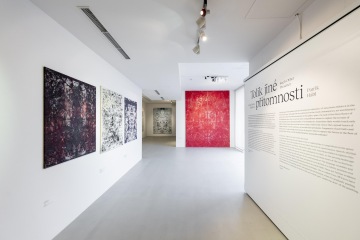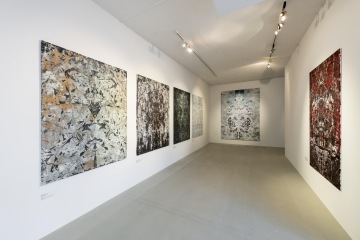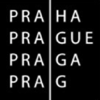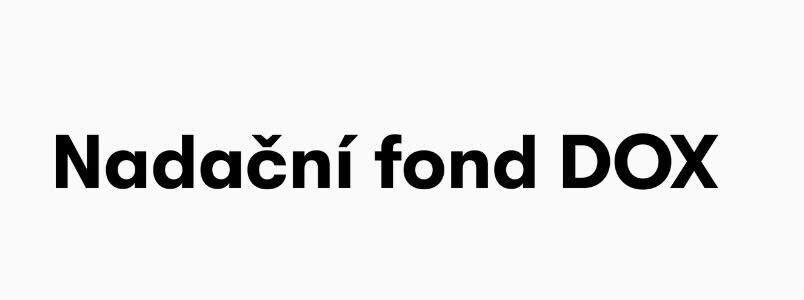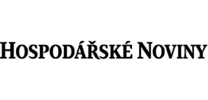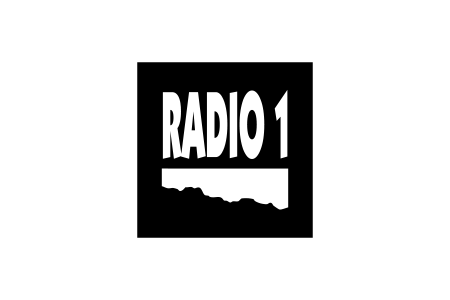Between painting and poetry: Patrik Hábl and Anna Beata Háblová in a joint exhibition at DOX
26 Jan 2022
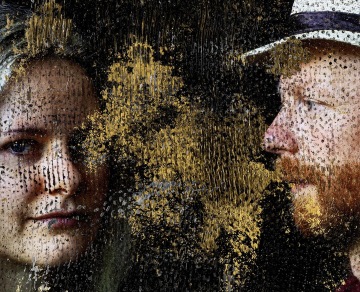
Contact for International media
Exhibition curator: Michaela Šilpochová
michaela@dox.cz
+420 774 222 355
On three floors of the tower of the DOX Centre for Contemporary Art, the exhibition Such Other Presence presents the paintings of Patrik Hábl in dialogue with the literature and poetry of Anna Beata Háblová. Although both are well known on the contemporary art and literary scene, this is their first joint presentation in the gallery space. The exhibition will run until 24 April 2022.
Patrik Hábl and Anna Beata Háblová meet in a joint dialogue on three floors of the exhibition space of the DOX Centre tower, where they use various means to explore the terrain of their medium and test the permeability of its boundaries. Sometimes their worlds touch only lightly, at other times they are in the closest contact. Before the viewer, they spread traces of images, threads of stories, and layers of possible interpretations.
Patrik Hábl (*1975) has become known to the public primarily for his monumental interventions of abstract art into important (often sacred) historical and contemporary buildings and permanent gallery exhibitions. While these interventions in public space and dozens of solo exhibitions in the Czech Republic and abroad have so far been dominated by abstract painting, in the exhibition Such Other Presence, Patrik Hábl presents an almost unknown position of his work inspired by his long-standing fascination with classical portraiture and the human face. “The motif of the face is as old as humanity itself. In the three separate series I present here, faces past, present, and future are intertwined,” the author says.
Anna Beata Háblová (*1983), originally an architect and urban planner, has in recent years focused on working with the word, in its spoken, written, and heard form. She is the author of four collections of poetry and one novel, and she also works in the genre of slam poetry. She is interested in the intervention of words in public space and the way in which text can respond to architecture and urbanism as well as art. In her exhibition at the DOX Centre, she explores different forms and positions of the text - from the poetic form and its intervention in a specific exhibition space, to the poem in audio-visual form, to the novel as an art installation.
On the first floor of the exhibition, Patrik Hábl presents a series of black-and-white portraits, entitled Faces (2020-21), which he created in response to the untimely passing of his brother and in the midst of a pandemic as a tribute to the premature deaths of well-known and completely unknown figures. Anna Beata Háblová’s direct response to this series is a series of poems in the form of haiku, which sound in her voice into the silence. “Faces that look out of images also look out of words. The silence here is like a wall on which the paintings of haiku hang,” the author comments on the joint installation.
Anna Beata Háblová presents a different position of text and word in her video installation Eco Slam on the second floor of the exhibition. It is based on the principles of slam poetry, a genre that the author has been working on for several years and works with the principle of the disintegration of image and language. The text loses its clarity, breaking on its own rhythm until it reaches a robotic position, hovering over the series of monumental, abstract, dehumanized faces of Patrik Hábl. Since 2014, the so-called Torn-off Faces have been created in a very specific way - through layered painting and its subsequent deconstruction, whereby the author, in his own words, gets “under the skin” of the painting by gradually peeling off individual layers of the painting, which the viewer can then enter imaginatively.
On the top floor, the exhibition culminates in an installation consisting of a large-scale collection by Patrik Hábl entitled Faces of the Old Masters and a novel in the space of Anna Beata Háblová. The series of 102 canvases, which Patrik Hábl is presenting to the public for the first time in its complete form, was created over a long period of almost thirty years. During these years, the artist has been creating copies of mostly iconic works by artists such as Albrecht Dürer, Leonardo da Vinci, Rembrandt, but also Vincent van Gogh and Edvard Munch using traditional techniques. He then “deconstructs” the formal procedures of classical brush painting and reinterprets each face in a different technique. In this way, he opens up the possibilities of new interpretations of classical works through a 21st-century painterly lens. It is precisely the exploration of (even several) painting processes and the development of new techniques in connection with their effect on the viewer’s imagination that forms the link between the work of Patrik Hábl and the cycle Faces of the Old Masters.
Questions related to the art of painting and the reinterpretation of the classical form are also of interest to Anna Beata Háblová in her debut novel Směna (Shift), which she has conceived as a spatial installation in the gallery environment. The novel, which will be published in book form this year by Host, is the testimony of a young visual artist who balances between the desire for artistic expression and the rejection of everything related to painting. Just as the possibility of “reading” disappears in the portraits of the Old Masters in the installation, Anna Háblová’s novel can be captured by the viewer in a mere fragment due to its scale.
“Connecting the world of art and the world of literature is an adventure. If you look at art through the eyes of literature and at literature through the eyes of art, you will look differently and think differently, at least for a while. And that is what we wanted to try to do in the exhibition,” says Michaela Šilpochová, curator of the exhibition, who approached the artists to collaborate with them precisely because in their work the two worlds meet quite naturally.
The exhibition will be accompanied by a series of programmes focusing on literature and art, educational programmes for schools, guided tours, and workshops, as well as workshops for children with Patrik Hábl and Anna Háblová.
A catalogue is being prepared for the exhibition.
Patrik Hábl (* 1975) is a painter working with image and space. He has created several monumental spatial entries of contemporary art into important historical buildings, such as the intervention of “Lenten paintings" in the academic St. Salvator’s Church in Prague, interventions in the permanent exhibitions of the National Gallery in Prague and the Aleš South Bohemian Gallery in Hluboká nad Vltavou (2016) and an installation in the church of Speinshart Monastery (2016). At the beginning of 2017, he created a ten-metre-long Lenten canvas for the Leechkirche, the oldest church in Graz, and in the same year, in the Small Fortress of the Terezín Ghetto, he encircled the perimeter of cell No. 41 with a painting consisting of 600 figures. He has repeatedly captured the public’s attention, for example, with his monumental painting of the Waterfall on an apartment building in Prague’s Žižkov district (2020) or a large-scale mural at the Landscape Festival in Krnov (2021). He collaborated with architect Stanislav Fiala on the realization of Drn Palace and Špork Palace.
His solo exhibition Transformation of the Landscape (2013) at the DOX Centre for Contemporary Art, where he transformed the exhibition space into an imaginary chapel with his works, drew great acclaim. In 2015, he was selected by an expert jury for the Beijing Biennale and presented his works in Kyoto, Japan, and a year later at the traditional Takeda House in Takaoka, Japan. In the same year, he created a monumental painting (100 m2) in the large riding hall of the Aleš South Bohemia Gallery, which was part of his large solo exhibition entitled In the Architecture of Painting. Patrik Hábl’s work has been awarded the Waldes Prize, the Europol Prize, and the Graphic Design of the Year Award. He was nominated in the top 10 as Personality of the Year for the most significant artistic achievement of 2013. He became the first living Czech whose paintings have been repeatedly included by Christie’s and Sotheby’s in the world's selection of the best artworks of the 20th and 21st centuries. Patrik Hábl teaches at the Academy of Art, Architecture and Design in Prague.
Anna Beata Háblová (*1983) is a writer, poet, slammer, architect, and urban planner. She has won the Young Architect Award (2010) and the Young Planning Professionals Award (2012) for her architectural designs and theoretical work. In 2017, she published a popular science book, Města zdí (Cities of Walls), about the history, interpretation, and background of shopping centers in relation to the city. Since 2018, she has been preparing reports on architecture for the Czech Radio and since 2020 also for Czech Television. Her most recent book on the border between genres is Nemísta měst (Nonplaces of Cities) (Host, 2019) about neglected, ephemeral and passed over places. She is the author of four collections of poetry. Her poems and short stories have also appeared in the literary journals Host, Tvar, Weles, Pandora and others, and have been translated into several European languages. In 2021, her poems were exhibited at Artwall Gallery (Unspeakable, 2021) and at Shrine of the Infant Jesus of Prague (Haiku Against Hopelessness, 2021). She is a committee member of the Writers’ Association. She is currently preparing her first novel, Směna (Shift).
Such Other Presence
27 January 2022 – 24 April 2022
Exhibition curator: Michaela Šilpochová



















